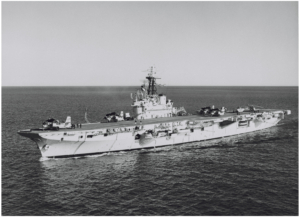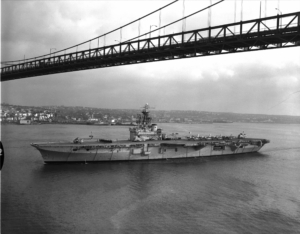OFFICIAL HISTORY OF
The Light Fleet Aircraft Carrier, HMCS BONAVENTURE, was laid down as HMS Powerful in November 1943 in the yards at Belfast of the shipbuilding firm of Harland and Wolff and launched there on 25 February 1946. In May, work was stopped on her. The Royal Canadian Navy needed a replacement for HMCS MAGNIFICENT and obtained approval from the Cabinet to purchase the still-unfinished ship. The British Admiralty placed a contract with the builders for the completion of the ship on Canada’s behalf. Work was then resumed on her and she was commissioned finally in the Royal Canadian Navy on 21 January 1957. The name of the carrier was taken from a small island off the Gaspé Peninsula in the Gulf of St. Lawrence, known as Ile Bonaventure.
Before she could cross the Atlantic, there were months of trials and tests for the ship. She finally sailed for passage on 19 June. Fog and a crowd of well-wishers awaited her at Halifax.
The years that followed BONAVENTURE’s arrival at her home base were occupied with exercising in company with other ships and with the training of men, those activities that are the principal ones for the larger ships in peacetime. While she manoeuvred with squadrons of destroyers, flying off and receiving back her aircraft, a destroyer escort steamed on her quarter, alert to hasten to the rescue of its occupants should an aircraft crash into the sea on landing or taking-off.
As well as with Canadian ships, she shared exercises with US and British ships and with those of other NATO countries. This activity took her many times to Bermuda and Caribbean waters, as well as to the United States, Britain and the Mediterranean.
It was while crossing the Atlantic in company with the First Canadian Escort Squadron to take part in a NATO exercise that, on 23 September 1962, she and HMCS ATHABASKAN (as plane guard) were ordered to detach and proceed to a point 500 miles off the Irish coast. There, due to engine failure, a Super-Constellation aircraft, belonging to the American Flying Tiger Airlines, had been forced down with 76 persons aboard.
The scene of the disaster was 320 miles away. From first light on the 24th, BONAVENTURE kept her aircraft in the air, combing the surface of the ocean for signs of survivors. At noon, they intercepted the Swiss SS Celerina. At about 0330, she had picked up forty-eight survivors from a raft. Four of them were badly injured and were transferred by helicopter to BONAVENTURE where they could receive medical attention. Although the aircraft aboard the carrier searched systematically for many hours, no more survivors were found.
Of a different nature was BONAVENTURE’s chief operation of 1964. In Cyprus that year, the ancient conflict between Greek and Turkish residents reached a crisis. To ensure that it did not develop into open warfare, the United Nations formed a peacekeeping force to which Canada was invited to contribute troops and supplies. In order to convey them to the Mediterranean, BONAVENTURE was ordered home from Gibraltar where she was taking part in NATO exercises. This was on 7 March and she reached Halifax on the 13th. She was scarcely secured to the jetty when work began loading her with vehicles, stores, ammunition and Tracker aircraft. On the 18th, troops came aboard and she sailed for Famagusta, Cyprus, where she came to anchor on the 30th. After the stores and troops had been landed and the ship’s company had been granted a day of relaxation in the port, the aircraft carrier with attendant destroyer escorts left for Malta and Gibraltar, to each of which she made short visits, and then crossed the ocean to Norfolk, Virginia, to begin a series of tests with Douglas Skyhawk aircraft.
HMCS BONAVENTURE remained an active and useful member of the fleet until her paying off on 3 July 1970. She was put up for sale and a broker bought her and resold her to the firm of Mitsui of Japan. This company entered into partnership with Tung-Cheng Iron and Steel Works in the southern Taiwan port of Kaohsiung, for the purpose of scrapping the carrier. In October 1971, a spokesman for the Taiwan company reported that about 40% of the ship had been broken up and that completion of the work could be expected in another two months.



 CFB Esquimalt Naval and Military Museum
CFB Esquimalt Naval and Military Museum
 CFB Esquimalt Naval and Military Museum
CFB Esquimalt Naval and Military Museum CFB Esquimalt Naval and Military Museum
CFB Esquimalt Naval and Military Museum CFB Esquimalt Naval and Military Museum
CFB Esquimalt Naval and Military Museum CFB Esquimalt Naval and Military Museum
CFB Esquimalt Naval and Military Museum CFB Esquimalt Naval and Military Museum
CFB Esquimalt Naval and Military Museum CFB Esquimalt Naval and Military Museum
CFB Esquimalt Naval and Military Museum CFB Esquimalt Naval and Military Museum
CFB Esquimalt Naval and Military Museum CFB Esquimalt Naval and Military Museum
CFB Esquimalt Naval and Military Museum CFB Esquimalt Naval and Military Museum
CFB Esquimalt Naval and Military Museum CFB Esquimalt Naval and Military Museum
CFB Esquimalt Naval and Military Museum CFB Esquimalt Naval and Military Museum
CFB Esquimalt Naval and Military Museum
 CFB Esquimalt Naval and Military Museum
CFB Esquimalt Naval and Military Museum CFB Esquimalt Naval and Military Museum
CFB Esquimalt Naval and Military Museum CFB Esquimalt Naval and Military Museum
CFB Esquimalt Naval and Military Museum CFB Esquimalt Naval and Military Museum
CFB Esquimalt Naval and Military Museum CFB Esquimalt Naval and Military Museum
CFB Esquimalt Naval and Military Museum CFB Esquimalt Naval and Military Museum
CFB Esquimalt Naval and Military Museum CFB Esquimalt Naval and Military Museum
CFB Esquimalt Naval and Military Museum CFB Esquimalt Naval and Military Museum
CFB Esquimalt Naval and Military Museum CFB Esquimalt Naval and Military Museum
CFB Esquimalt Naval and Military Museum CFB Esquimalt Naval and Military Museum
CFB Esquimalt Naval and Military Museum

 CFB Esquimalt Naval and Military Museum
CFB Esquimalt Naval and Military Museum CFB Esquimalt Naval and Military Museum
CFB Esquimalt Naval and Military Museum CFB Esquimalt Naval and Military Museum
CFB Esquimalt Naval and Military Museum CFB Esquimalt Naval and Military Museum
CFB Esquimalt Naval and Military Museum CFB Esquimalt Naval and Military Museum
CFB Esquimalt Naval and Military Museum
 CFB Esquimalt Naval and Military Museum
CFB Esquimalt Naval and Military Museum



 CFB Esquimalt Naval and Military Museum
CFB Esquimalt Naval and Military Museum



































 CFB Esquimalt Naval and Military Museum
CFB Esquimalt Naval and Military Museum CFB Esquimalt Naval and Military Museum
CFB Esquimalt Naval and Military Museum
 CFB Esquimalt Naval and Military Museum
CFB Esquimalt Naval and Military Museum